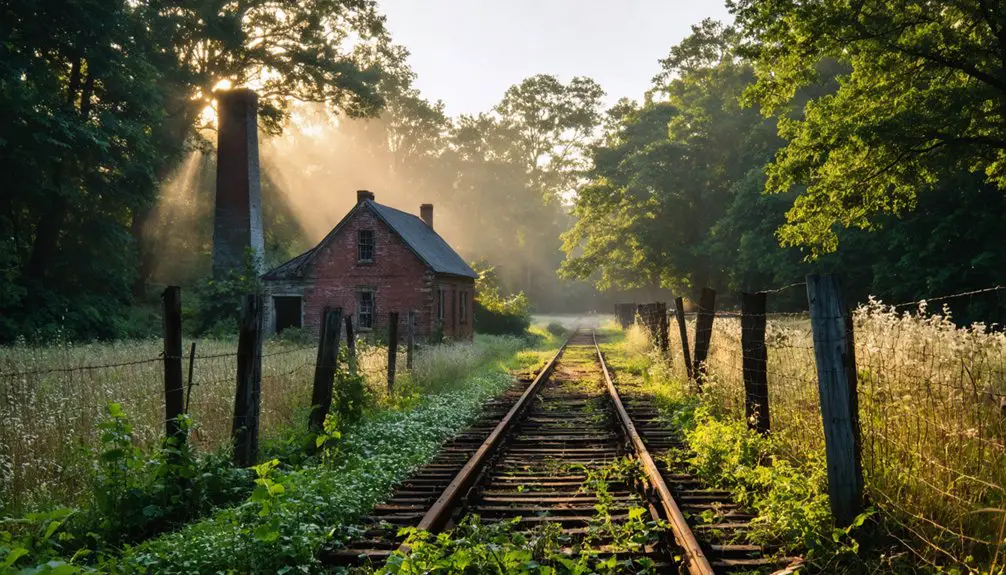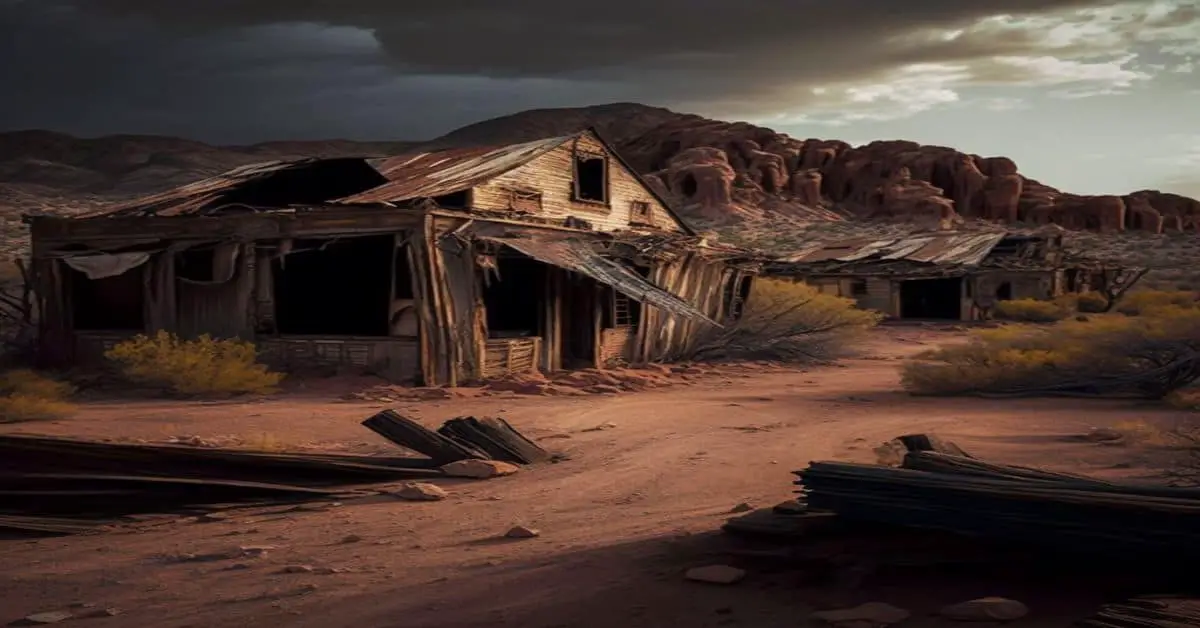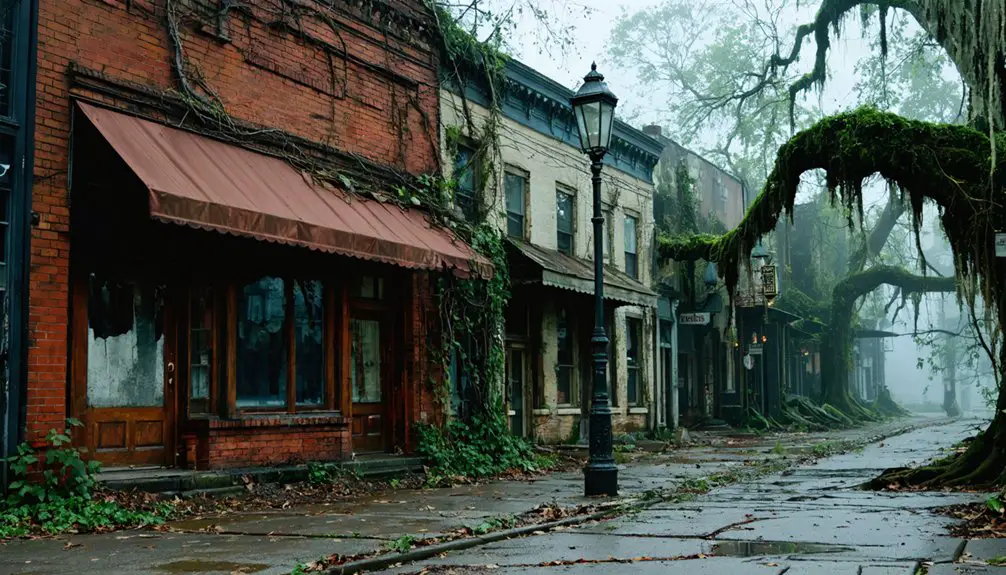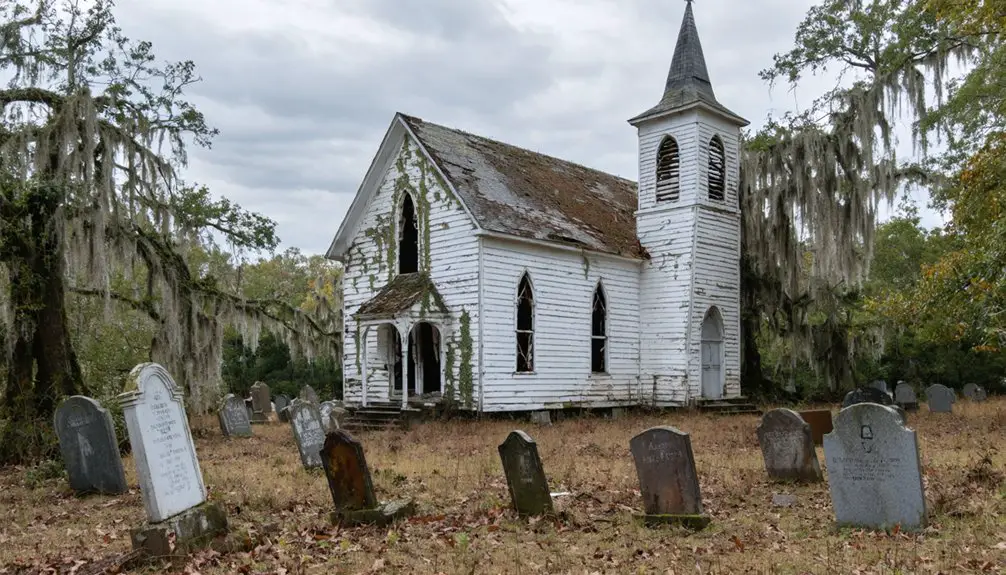You’ll find Ellenton’s ghostly remnants buried beneath the Savannah River Site, one of America’s most restricted nuclear facilities. In 1950, President Truman ordered the complete evacuation of this thriving South Carolina trading town, forcing 6,000 residents to abandon their homes for Cold War nuclear production. While New Ellenton was established eight miles away, the original town’s streets and sidewalks still whisper stories of the tight-knit community that sacrificed everything for national security.
Key Takeaways
- Ellenton was a thriving South Carolina town until 1950, when it became a ghost town due to the Savannah River nuclear facility construction.
- The U.S. government displaced 6,000 residents, including 700 from Ellenton, to build one of the world’s largest nuclear weapons facilities.
- Original streets, sidewalks, and driveways remain visible but overgrown within the restricted Savannah River Site complex.
- The town’s forced evacuation scattered tight-knit communities, with residents relocating to New Ellenton, eight miles from the original site.
- Annual reunions since 1973 help preserve the memory of the abandoned town and maintain connections among former residents.
The Rise of a Southern Trading Hub (1880-1950)
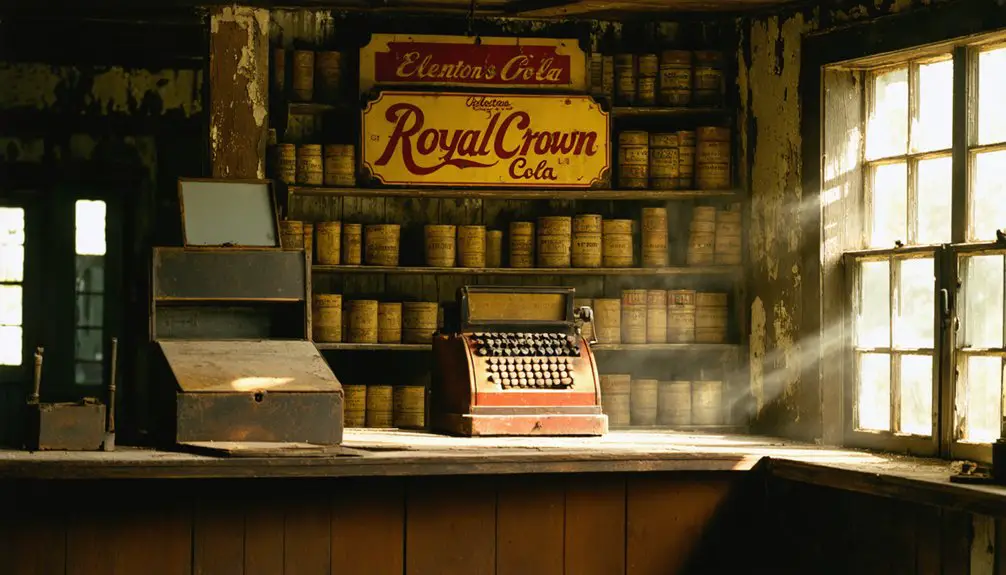
While many small Southern towns emerged during the post-Reconstruction era, Ellenton’s incorporation in 1880 marked the beginning of a distinctive trading center in South Carolina.
Starting with just 94 residents, you’d have witnessed the town’s trading significance grow through its strategic mix of agriculture, timber, and sawmill operations. The arrival of the Port Royal and Augusta Railroad helped establish Ellenton as a vital transportation hub.
Like other locations documented in place name disambiguation records, Ellenton established itself as a notable geographical point in South Carolina’s history.
A Town’s Sacrifice for National Security
You’ll find it hard to imagine that Ellenton’s bustling streets and close-knit community vanished in 1950 when President Truman ordered the town’s complete removal for America’s Cold War hydrogen bomb production program.
Former residents now face severe health risks if they attempt unauthorized visits to their old hometown. The government’s $19 million acquisition of 210,000 acres forced 6,000 residents, including 700 from Ellenton proper, to abandon their homes and relocate their dead from 150 graveyards to make way for the massive Savannah River Site nuclear facility.
What was once your typical Southern trading town now lies buried beneath one of the world’s most contaminated nuclear sites, its memory preserved only through oral histories and the displacement stories of families who rebuilt their lives in nearby New Ellenton. The project’s massive scale required moving enough earth to construct a wall 2,500 miles long and ten feet high.
Cold War Military Necessity
In response to escalating Soviet threats during the Cold War, the U.S. government’s decision to construct the Savannah River Plant transformed Ellenton into a sacrifice zone for national security.
You’ll find that military strategy drove the dramatic transformation of this rural South Carolina landscape into a critical nuclear weapons facility. The plant’s massive 300-square-mile footprint wasn’t arbitrary – it reflected the need for isolation and secrecy while producing roughly 40% of the world’s Cold War plutonium.
This industrial behemoth became essential to America’s nuclear deterrence capabilities, particularly in maintaining second-strike readiness against Soviet aggression. Over fifteen hundred families were forced to leave their homes in towns like Ellenton, Dunbarton, Meyers Mill, and Leigh. The facility was established for thermonuclear materials production and waste management during the arms race.
Yet the government’s economic exploitation of vulnerable communities, especially Black tenant farmers, reveals a darker side of Cold War mobilization. The rapid seizure of their lands demonstrated how national security imperatives often overshadowed social justice.
Community Loss and Displacement
Behind the strategic calculations of Cold War defense lay the human cost of Ellenton’s transformation. You’d find nearly 6,000 residents, including many African-American farmers and sharecroppers, forced to abandon their homes, farms, and even family gravesites in 1950.
The tight-knit community’s identity shattered as the government acquired properties through purchase or condemnation. The cultural heritage of generations vanished as residents scattered to New Ellenton or beyond. The Savannah River Archeological Program now helps preserve what remains of this displaced community’s history.
While younger people left the area entirely, many older residents who stayed nearby didn’t survive long – over half died within a decade of eviction.
Today, you’ll see only traces of the original town: empty streets, curbs, and walkways where a vibrant community once stood. The sacrifice of Ellenton’s people remains a stark reminder of Cold War priorities.
Radioactive Site Transformation
When the U.S. Atomic Energy Commission selected the Savannah River site in 1950, you’d witness America’s most significant construction project since the Panama Canal. The government transformed 300 square miles of South Carolina communities into a classified nuclear facility, forever altering the region’s radioactive legacy. The site would become crucial for plutonium and tritium production needed for hydrogen bombs.
You’ll find that beneath the $250 million project lay the stories of 6,000 displaced residents who watched their homes, churches, and schools vanish for national security. The site’s vast perimeter, deemed necessary for radiation safety, erased towns like Ellenton and Dunbarton. The government acquired the land for ten dollars an acre or less through purchases and condemnation.
Yet community resilience emerged as residents established New Ellenton and Jackson, carrying forward their displaced heritage. Today, where South Carolina’s first automatic telephone system once operated, you’ll discover only traces of paved streets and curbs – silent witnesses to a town’s ultimate sacrifice for America’s Cold War arsenal.
Life After Displacement: The Birth of New Ellenton
If you’d grown up in the original Ellenton, you would’ve watched your entire community pack up and move north in 1950 as the new Savannah River Plant claimed your hometown for national security purposes.
Your neighbors might’ve physically moved their homes to the newly established town of New Ellenton, located eight miles away on U.S. Highway 278, where displaced residents worked to rebuild their sense of community from scratch. A poignant reminder of the town’s loss was expressed through a handmade shoe polish sign created by resident Bonner Smith in December 1950.
While adapting to life in New Ellenton brought challenges, you would’ve found comfort in annual reunions that began in 1973, allowing former residents to maintain their cherished connections to old Ellenton’s heritage.
Rebuilding Community From Scratch
The birth of New Ellenton marked a pivotal change for thousands of displaced residents following the 1950 announcement of the Savannah River Plant. You’d find a newly planned 200-acre site designed to house both displaced families and incoming plant workers, complete with modern infrastructure that would replace what they’d left behind in old Ellenton.
The community rebuilding effort wasn’t just about constructing buildings – it was about weaving together fragmented social networks.
You’ll understand how challenging this shift was, especially for African-American farmers and sharecroppers who lost not just their homes but their livelihoods. The shift from an agricultural economy to one centered around plant jobs transformed both occupational and community dynamics.
Despite these challenges, you’ll find that New Ellenton’s residents preserved their cultural memory through annual reunions and continued community gatherings.
Adapting To New Home
Life after displacement proved transformative for thousands of Ellenton residents who found themselves building new lives eight miles north along U.S. Highway 278.
The shift from rural agriculture to industrial employment marked a dramatic cultural adaptation, as families adjusted to modern infrastructure and new economic opportunities.
Key changes you’d experience in New Ellenton included:
- Trading cotton fields and sawmills for jobs at the Savannah River Site
- Accessing improved utilities and transportation networks
- Participating in annual reunions since 1973 to maintain old bonds
- Joining a more diverse workforce as community integration brought together residents from multiple displaced towns
Despite these changes, you’d find a determined spirit among residents who worked to preserve their heritage while embracing their role in America’s nuclear age.
Preserving Old Town Memories
Preserving memories of old Ellenton became a cherished mission for thousands of displaced residents who refused to let their heritage fade into obscurity. Since 1973, you’ll find former residents gathering at annual reunions, sharing stories and keeping their cultural heritage alive.
The Savannah River Archaeological Research Program leads memory preservation efforts, documenting the physical remnants of streets, walkways, and building foundations that still exist within the restricted site.
Through public historic tours along the Ellenton Trail, you can witness the tangible links to this lost community. The SRS Cold War Historic Preservation program actively collects artifacts and stories, ensuring future generations understand the sacrifice of those who were relocated.
Despite the physical distance, former residents maintain strong connections through these heritage initiatives and community gatherings.
Hidden Streets and Memories: What Remains Today
Beneath the secure perimeter of today’s Savannah River Site, ghostly remnants of Ellenton’s streets and sidewalks still trace the outline of a once-vibrant South Carolina town.
These hidden pathways tell stories of lives suddenly uprooted during the Cold War era, while community artifacts occasionally surface to remind us of those who called this place home.
You’ll find these remaining features within the restricted site:
- Original paved streets and curbs, now overgrown but still visible
- Driveways and walkways marking where homes once stood
- Archaeological sites yielding cultural items from daily life
- Historic road networks now serving as heritage trails
While you can’t freely explore these remnants, guided tours occasionally allow you to walk where Ellenton’s residents once lived, offering glimpses into a community that sacrificed everything for national interests.
The Human Cost of Cold War Progress
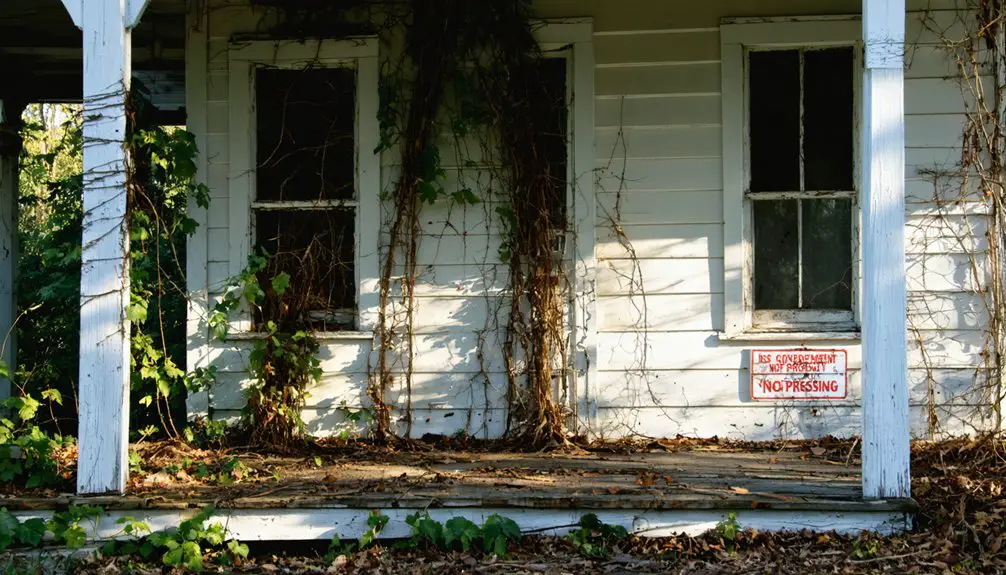
The Cold War’s profound human toll became starkly evident in November 1950, when federal authorities ordered 6,000 residents of Ellenton and its surrounding communities to abandon their homes.
You’ll find the starkest economic disparities in how the government compensated landowners, paying as little as $10 per acre while the lumber alone was worth substantially more.
The displacement hit African American farmers and sharecroppers particularly hard, exposing racial inequities in both land ownership and compensation.
African American residents bore a disproportionate burden, facing systemic discrimination in both property rights and financial restitution during the forced relocation.
You can trace how this forced evacuation fractured tight-knit communities, separated families from ancestral lands, and disrupted generations of rural life.
While some found new beginnings in nearby New Ellenton, others scattered across the country, carrying the weight of their sacrificed hometown for America’s nuclear ambitions.
Preserving Ellenton’s Legacy for Future Generations
While physical traces of Ellenton have largely vanished, dedicated preservation efforts guarantee its legacy endures through multiple channels.
Today, you’ll find memory preservation initiatives actively protecting this important piece of Cold War history through:
- The University of South Carolina’s Archaeological Research Program, which manages artifacts and historic resources
- The SRS Heritage Foundation’s guided tours and educational events that keep community stories alive
- Ongoing collection of oral histories from former residents, documenting their personal experiences
- Regional school programs and historical markers that educate future generations
Through community engagement, former residents can still visit their hometown on special occasions, while New Ellenton carries forward the community’s spirit.
The SRS Cold War Historic Preservation program guarantees these sacrifices and stories won’t be forgotten, balancing security needs with historical preservation.
Frequently Asked Questions
What Happened to the Pets and Livestock During the Forced Relocation?
Painfully, pets perished or parted ways with their people during pet evacuation, while you’d find livestock likely sold hastily or abandoned. There’s no documented protocol for animal welfare during the forced displacement.
Were There Any Residents Who Refused to Leave Their Homes?
While residents’ stories reveal deep emotional resistance, you won’t find documented cases of people physically refusing to leave. The government’s authority and compensation guaranteed compliance, though haunted memories persist today.
Did Any Nuclear Accidents Occur Near the Former Town Site?
You’ll be relieved to know no major nuclear accidents occurred there. The closest incident was a 1958 nuclear bomb drop in Mars Bluff, 50 miles away, though nuclear safety and environmental impact remained ongoing concerns.
How Much Compensation Did Residents Receive for Their Properties?
You’d receive SCDOT’s baseline $72,000 for taken land, plus $445,000 for property value losses due to accessibility issues. Compensation disputes could increase payouts through successful litigation and damage claims.
What Was the Crime Rate in Ellenton Before Its Abandonment?
You’d be more likely to find Bigfoot’s tax returns than accurate crime statistics from pre-1950s Ellenton. While New Ellenton’s later data shows relatively safe community safety patterns, original Ellenton’s crime rates remain unknown.
References
- https://www.onlyinyourstate.com/state-pride/south-carolina/old-ellenton-abandoned-town-sc
- https://strangetalespodcast.wordpress.com/2007/04/09/ellenton-sc-a-town-no-more/
- https://en.wikipedia.org/wiki/Ellenton
- https://www.energy.gov/em/articles/savannah-river-site-walking-tours-revisit-former-town-ellenton
- https://www.youtube.com/watch?v=BdPrIAS6jR0
- https://cityofnewellenton.sc.gov/resources/ellenton-history
- http://ellentonsc.com/history.html
- https://www.scencyclopedia.org/sce/entries/new-ellenton/
- https://cityofdust.blogspot.com/2005/02/dead-towns-south-carolina.html
- http://kzfr.org/broadcasts/21787
